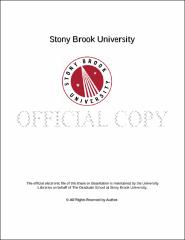| dc.identifier.uri | http://hdl.handle.net/11401/76651 | |
| dc.description.sponsorship | This work is sponsored by the Stony Brook University Graduate School in compliance with the requirements for completion of degree. | en_US |
| dc.format | Monograph | |
| dc.format.medium | Electronic Resource | en_US |
| dc.language.iso | en_US | |
| dc.publisher | The Graduate School, Stony Brook University: Stony Brook, NY. | |
| dc.type | Dissertation | |
| dcterms.abstract | The evidence for dark matter is overwhelming. We know where the dark matter is, how much there is, but we do not know what type of particle it consists of. Experimental efforts, as well as theoretical, have tried to shed light on its identity. On the experimental side, “indirect detection†aims to detect stable leptons, baryons, or photons resulting from the annihilation or decay of dark matter particles in outer space. On the other hand, “direct detection†experiments have the goal to reveal interactions of the dark matter particles with electrons or nuclei in a detector on Earth. To date, none of these endeavors has found convincing evidence for dark matter detection. In this dissertation I will describe two ideas to constrain and probe dark matter. One project focuses on indirect detection, where we used all-sky data from the Fermi-LAT gamma-ray space telescope. We developed a new method to optimize the choice of the data subsets used to derive constraints on theoretical models, with the aim of making the bounds as strong, and yet conservative, as possible. The other project is on direct detection. Here we propose a new experimental concept to probe dark matter with masses as low as 1 MeV. The experiment is sensitive to possible interactions between dark matter particles and electrons within a scintillating target material under cryogenic conditions. Such interactions could eventually produce one or more photons. These photons could be revealed using state-of-the-art zero-dark-count single-photon detectors such as MKIDs or TES. The proposed experimental concept could open up vast new regions of the dark matter parameter space. | |
| dcterms.available | 2017-09-20T16:50:52Z | |
| dcterms.contributor | Essig, Rouven | en_US |
| dcterms.contributor | Hobbs, John | en_US |
| dcterms.contributor | Meade, Patrick | en_US |
| dcterms.contributor | Soni, Amarjit. | en_US |
| dcterms.creator | Massari, Andrea | |
| dcterms.dateAccepted | 2017-09-20T16:50:52Z | |
| dcterms.dateSubmitted | 2017-09-20T16:50:52Z | |
| dcterms.description | Department of Physics | en_US |
| dcterms.extent | 153 pg. | en_US |
| dcterms.format | Application/PDF | en_US |
| dcterms.format | Monograph | |
| dcterms.identifier | http://hdl.handle.net/11401/76651 | |
| dcterms.issued | 2016-12-01 | |
| dcterms.language | en_US | |
| dcterms.provenance | Made available in DSpace on 2017-09-20T16:50:52Z (GMT). No. of bitstreams: 1
Massari_grad.sunysb_0771E_12938.pdf: 5867418 bytes, checksum: cfd4c3b91a5d75d1a13b315d63f677f9 (MD5)
Previous issue date: 1 | en |
| dcterms.publisher | The Graduate School, Stony Brook University: Stony Brook, NY. | |
| dcterms.subject | Theoretical physics -- Astrophysics -- Particle physics | |
| dcterms.subject | dark matter, fermi, light dark matter, optimization, scintillator, semiconductor | |
| dcterms.title | Searching for dark matter with the Fermi-LAT and through new experimental ideas | |
| dcterms.type | Dissertation | |

